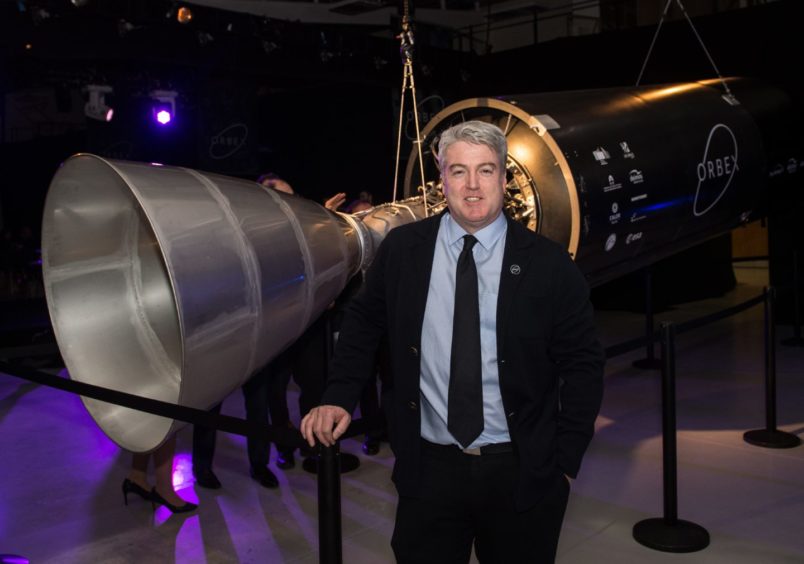Spaceflight company Orbex chief executive Chris Larmour says he is “not concerned about ego” in terms of who wins the race to launch satellites into orbit from north Scotland as the Forres-based rocket maker readies for blast-off.
Just last week Orbex showed off the first full-scale prototype on its launchpad of the Prime orbital rocket due to shoot 5o miles high from Space Hub Sutherland in Melness possibly in the first half of next year.
The bolted-down rocket will now undergo several rigorous dress rehearsals “to debug systems.”
“We haven’t been beating our chests”
“We are running at our own pace and our own race” Mr Larmour told the Press and Journal. “We are not really too concerned about who is first to launch or that kind of ego stuff.
“We haven’t been out there beating our chests (but) there we are, the first people in Europe to put out an orbital microlauncher. A lot of people are talking about it but we have actually delivered – it is more about delivery than hot air.”
Mr Larmour coyly limits himself to hoping the launch will be “first-half next year” but adds “the last thing we want is an on-time failure,” as there is “always a chance” rockets fail.
Satellites the size of shoeboxes
Shetland and Sutherland are jockeying to be ready for rocket launches with SaxaVord UK Spaceport based at the former RAF base on Unst recently inking a third rocket company deal following an agreement with Astra Space.
The move comes hot on the heels of tie-ups between the Shetland site on the Lamba Ness peninsula with US-based ABL Space Systems and Scottish rocket company Skyrora for launches.
Orbex plans to launch satellites – “around the size of a shoebox” – from Space Hub Sutherland which was the first vertical spaceport to receive planning permission in the UK and from where the company’s 19m resuable rocket will blast off.
WATCH: 40-tonne Orbex rocket lifted into place at launch test site in Kinloss.
There are “thousands of applications” for small satellites and Orbex has already sold six launches. It is allowed up to 12 per year from Sutherland.
Customers could include providers of gaming applications, shipping trackers, those wanting to monitor automotive freight, wildebeest migration and ice depletion as well as sanctions busting, with those companies looking for the technology to fly from north to south poles.
That is why north Scotland is “such a good launch site” as there are 2,200 miles of open sea to the North Pole insists Orbex, which is stressing the transferability of local skills to the hi-tech sector.
“We are in Moray because we need to be relatively close to the spaceport, close to infrastructure such as airports and to sources of talent,” added Mr Larmour. “We have got Lossiemouth in our area so we can pick up people who have experience in avionics and airframes.
“The oil and gas industry around Aberdeen and the Moray Firth, there are a lot of people who are very familiar with high quality welding, tanks, gases, cryogenic fluids; a lot of skillsets we need in our business.”
Plans to grow to 400 people
Orbex is looking to massively increase the current workforce of 65 more than six-fold in the next “three to four years” as it gears up for a first small satellite launch and is now on the hunt for those able to transfer skills across to what could become a booming industry for the Moray Firth.
“We employ 65 people in Forres now and the plan is to grow to 400 people in the next three to four years – the vast majority will be local,” added Mr Larmour.
Other technical posts available will be in software and carbon fibre disciplines – “high-wage jobs” – whose potential creation triggered backing from Highlands and Islands Enterprise (HIE) with a £1.5m grant (half as loan).
The company is also funded by venture capital funds, BGF and Octopus Ventures, which join Heartcore Capital and High-Tech Gründerfonds, as well as investor Elecnor, parent company of Deimos Space, the UK Space Agency (UKSA) and the European Space Agency (ESA).
“We are the laptops of rockets”
Mr Larmour, who has an engineering and telecoms background conceded, “we are never going to be BP,” but pointed to the dazzling array of CVs its current staff have brought to the company including spells with NASA, ESA, Ariane and aerospace giant Lockheed Martin.
“This rocket we can build with $100m,” he noted. “That is then in the scale of venture capital and some grant funding.
“We are the laptop of rockets. Because the rockets are much smaller you don’t need Cape Canaveral – you need a smaller spaceport that can fit in smaller regions like the north coast of Sutherland where you need 10m x 10m.
“People think it’s going to be Saturn V (moon rocket), Cape Canaveral but it’s really not.”
What is an Orbex rocket?
Prime is a 19-metre long, two-stage rocket powered by seven engines designed and manufactured in the UK and Denmark.
The six rocket engines on the first stage of the rocket will propel the vehicle through the atmosphere to an altitude of around 50 miles.
The single engine on the second stage of the rocket will complete the journey to low earth orbit (LEO), allowing the release of its payload of small, commercial satellites.
Environmentally-friendly
Orbex Prime is powered by a renewable bio-fuel, bio-propane, supplied by Calor UK.
It is also a re-usable rocket which has been engineered to leave zero debris on earth or in orbit.
Orbex has its headquarters, production and testing facilities in Scotland with design and testing sites in Denmark.




Conversation